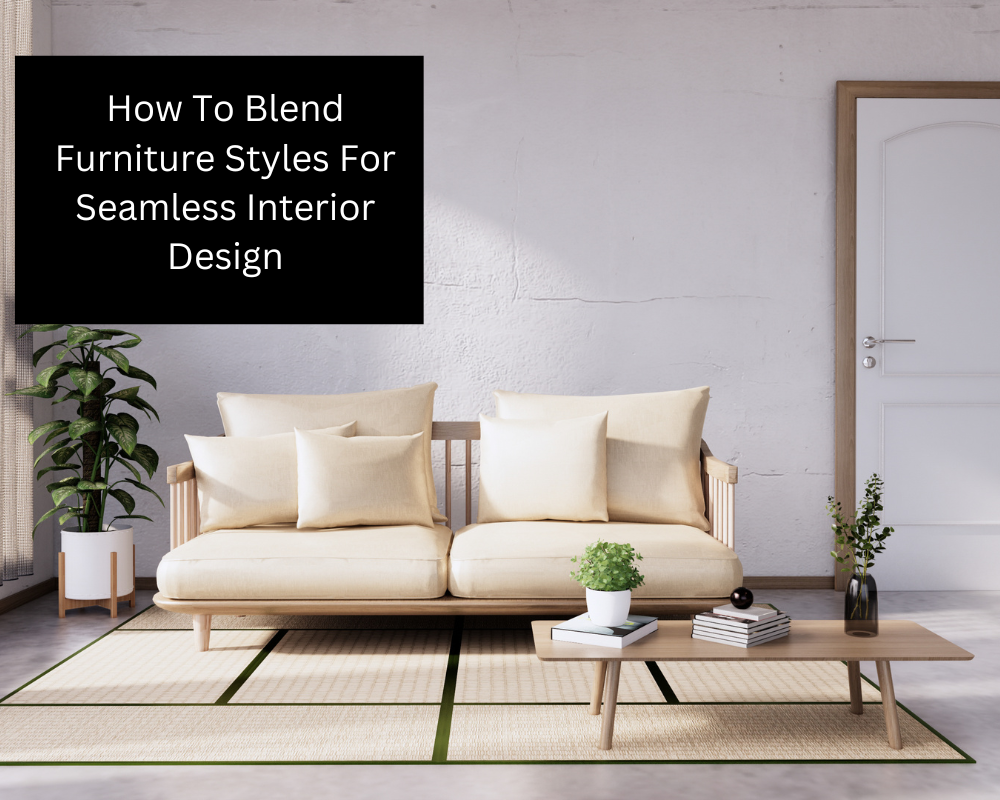How To Blend Furniture Styles For Seamless Interior Design
Creating a beautiful and cohesive interior design is an art that involves various elements coming together harmoniously. One of the key aspects of a well-designed space is blending furniture styles effectively. Mixing different furniture styles can add depth, character, and personality to your home while showcasing your individuality. However, achieving a seamless blend of furniture styles can be a challenging task. In this blog post, we’ll explore some essential tips and tricks to help you achieve a cohesive and stunning interior design by blending furniture styles flawlessly.
Understanding Your Design Aesthetic
Before you start blending furniture styles, it’s essential to have a clear understanding of your design aesthetic. Do you lean towards modern minimalism, traditional elegance, rustic charm, or a mix of eclectic elements? Identifying your design style will serve as a guiding principle while selecting furniture pieces, ensuring they align with your vision. Take time to explore different design styles and identify the elements that resonate with you the most.
When you have a dominant design style in mind, consider whether you want to maintain its consistency throughout your home or introduce some variety by blending other styles. Remember, there are no strict rules in interior design, and mixing styles can lead to exciting and visually appealing results. The key is to strike the right balance and create a cohesive look that speaks to your tastes and preferences.
Start with Neutral Foundation
When blending furniture styles, it’s often helpful to begin with a neutral foundation. Neutral colours such as whites, greys, beiges, and soft pastels can act as a canvas for your design. They provide a versatile backdrop that allows different furniture styles to stand out while maintaining a sense of harmony. A neutral base also ensures that your interior doesn’t appear cluttered or overwhelming, especially when combining diverse elements.
For example, if you prefer a modern and minimalistic design, opt for neutral-coloured walls and simple, clean-lined furniture pieces as your foundation. On the other hand, if you lean towards a bohemian or eclectic style, consider neutral walls and floors with textures like jute or rattan furniture to create a cosy and inviting atmosphere.
Create Visual Balance
Achieving a seamless blend of furniture styles requires careful attention to visual balance. Balance refers to the distribution of visual weight in a space to create a sense of equilibrium. When combining diverse furniture pieces, you’ll want to ensure that one style doesn’t overpower the others.
One way to achieve visual balance is by using the “Rule of Three.” Select three main furniture styles that you want to incorporate and distribute them throughout the room. For instance, you could have a contemporary sofa, a vintage coffee table, and a set of modern dining chairs in the same space. Each style will hold its own weight and contribute to a balanced overall look.
Another technique is to use a statement piece to anchor the room. This standout furniture item, such as a unique antique cabinet or an eye-catching modern art piece, can become the focal point around which you blend the other styles. The statement piece adds interest and personality to the room, while the supporting furniture complements and enhances its presence.
In the next part of this blog post, we will explore more tips for blending furniture styles, including mixing patterns and textures, incorporating transitional pieces, and using colour strategically to tie everything together. With the right approach, you can transform your home into a harmonious and captivating space that truly reflects your style and taste. Stay tuned for the rest of the article, and we will guide you through the final steps of achieving a seamless interior design through furniture blending.
Read: The Importance of a Professional Roof Inspection after Severe Weather
Mix Patterns and Textures
Blending furniture styles doesn’t stop with selecting different pieces; it also involves combining various patterns and textures. Mixing patterns adds depth and visual interest to a room, while textures bring tactile appeal and cosiness. When done thoughtfully, this combination can create a dynamic and inviting space.
Start by choosing a dominant pattern that will set the tone for the room. It could be a bold geometric pattern on a rug, a floral print on throw pillows, or a striped accent wall. Once you have your primary pattern, select secondary patterns that complement it. Make sure to vary the scale of the patterns to avoid overwhelming the space.
Textures play a crucial role in adding warmth and dimension to a room. Incorporate different textures through furniture materials, such as a plush velvet sofa, a rustic wooden coffee table, or a sleek metal side table. Layering textures can help create a sense of balance and harmony, even when you have diverse furniture styles in the same space.
Introduce Transitional Pieces
Transitional furniture pieces are versatile and can act as a bridge between different styles. These pieces often combine elements from various design aesthetics, making them ideal for blending furniture styles seamlessly. Look for items that have clean lines and neutral colours, as they are more likely to complement a range of design styles.
For instance, a transitional dining table with a classic silhouette and a contemporary finish can work well in both traditional and modern interiors. A versatile sectional sofa in a neutral colour can effortlessly fit into various design schemes, acting as a transitional anchor in your living room.
Transitional pieces provide flexibility in your design choices and allow you to experiment with different styles without committing to a single look entirely. They are an excellent way to create cohesion while incorporating your favourite furniture styles.
Strategically Use Colours
Colour is a powerful tool in interior design and can help tie together different furniture styles. While blending styles, it’s essential to establish a cohesive colour palette that harmonizes with your design vision. Consider using a unifying colour or two that can be present in different furniture pieces, decorative accents, and accessories throughout the space.
An effective approach is to choose a dominant colour and use it in varying shades and intensities. For example, if you have a blue velvet sofa as a statement piece, you can use lighter shades of blue for the curtains and cushions or darker blues for smaller accessories like vases or artwork frames. This subtle repetition of colour creates a sense of rhythm and unity within the room.
Additionally, neutral colours like whites, greys, and beige can act as a common thread that connects different furniture styles. These colours can be used for walls, floors, and larger furniture items, providing a neutral backdrop that complements the various styles you incorporate.
Creating Your Perfect Interior
Blending furniture styles for a seamless interior design is an exciting opportunity to express your personality and create a unique, inviting space. By understanding your design aesthetic, starting with a neutral foundation, creating visual balance, mixing patterns and textures, introducing transitional pieces, and strategically using colours, you can achieve a harmonious and cohesive look.
Remember that interior design is an ongoing process, and it’s okay to experiment and make adjustments along the way. Be open to exploring new styles and finding the right pieces that resonate with you. With careful consideration and a touch of creativity, you can transform your home into a stunning reflection of your taste and style. Embrace the journey of blending furniture styles, and your home will become a true masterpiece of interior design. Happy decorating!
Author’s Bio:
This article was written by Eliza Cochrane, content writer for Margo and Plum home accessories.



